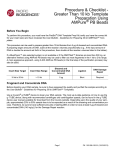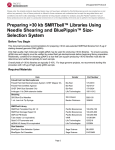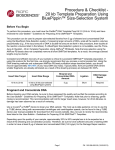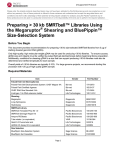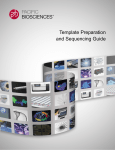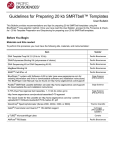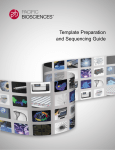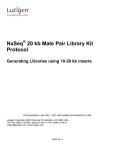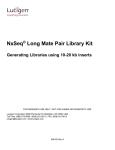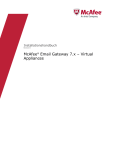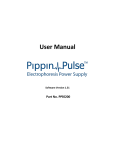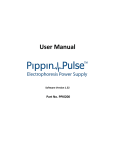Download Procedure & Checklist
Transcript
Procedure & Checklist Greater Than 10 kb Template Preparation Using AMPure® PB Beads Before You Begin To perform this procedure, you must have the PacBio® Template Prep Kit and have reviewed the User Bulletin Guidelines for Preparing 20 kb SMRTbell™ Templates. This procedure can be used to prepare greater than 10 kb libraries from 5 μg of sheared and concentrated DNA. If preparing larger amounts of DNA, scale all the reaction volumes proportionally (e.g., if the input amount of DNA is double the amount set forth in this procedure, then double all the reaction volumes listed in the tables). If a BluePippin™ size selected system is not available or if the SMRTbell™ libraries are less than 500 ng, an alternative method using AMPure PB beads may be used to filter out most fragments in the 1 kb to 2 kb range. A more aggressive approach, using 0.40X AMPure PB beads (in the final step of the purification process) may also be used. Insert Size Target Insert Size Range Sheared and Concentrated DNA Amount Ligation DNA Damage Repair 10 kb to 20 kb > 10 kb 5 μg Blunt Required Fragment and Concentrate DNA Before shearing your DNA sample, be sure to have assessed the quality and purified the sample according to the User Bulletin - Guidelines for Preparing 20 kb SMRTbell™ Templates. Use a Covaris® g-TUBE® device to shear your DNA sample. Review the recommendations listed in the User Bulletin - Guidelines for Preparing 20 kb SMRTbell™ Templates. The most up-to-date guidance on how to use the g- TUBE device, along with recommended centrifuges and centrifugation speeds, can be found in the gTUBE device user manual available for download from the Covaris website. Depending upon the quality of your sample, approximately 20% to 50% sample loss is to be expected as a result of the shearing and concentration process. Therefore, be sure to have sufficient amounts of starting DNA in order to have at least 5 μg of sheared and concentrated DNA (140 ng/μL) for the subsequent repair steps. Page 1 PN 100-286-100-04 STEP 1 Concentrate DNA Notes Add 0.45X volume of AMPure® PB beads. _____ μL of sample X 0.45X = _____ μL of beads Note that the beads must be brought to room temperature and all AMPure PB bead purification steps should be performed at room temperature. Before using, mix the bead reagent well until the solution appears homogenous. Pipette the reagent slowly since the bead mixture is viscous and precise volumes are critical to the purification process. Consistent and efficient recovery of your sample is critical to successful SMRTbell™ template preparation. If using this protocol for the first time, we strongly recommend that you process a control sample first. Using the DNA shearing methods and subsequent AMPure PB bead purification steps described below, you should recover approximately 50%-80% of your input DNA (by mass). Typical yields, from pre-purified DNA (where smaller fragments are already eliminated as a result of the shearing process) are between 80-100%. 2 Mix the bead/DNA solution thoroughly. 3 Quickly spin down the tube (for 1 second) to collect the beads. 4 Allow the DNA to bind to beads by shaking in a VWR® vortex mixer at 2000 rpm for 10 minutes at room temperature. Note that the bead/DNA mixing is critical to yield. After vortexing, the bead/DNA mixture should appear homogenous. We recommend using a VWR vortex mixer with a foam microtube attachment (see the Guide’s Overview section for part numbers). If using other instrumentation, ensure that the mixing is equally vigorous. Failure to thoroughly mix the DNA with the bead reagent will result in inefficient DNA binding and reduced sample recoveries. 5 Spin down the tube (for 1 second) to collect beads. 6 Place the tube in a magnetic bead rack until the beads collect to the side of the tube and the solution appears clear. The actual time required to collect the beads to the side depends on the volume of beads added. 7 With the tube still on the magnetic bead rack, slowly pipette off cleared supernatant and save in another tube. Avoid disturbing the bead pellet. If the DNA is not recovered at the end of this Procedure, you can add equal volumes of AMPure PB beads to the saved supernatant and repeat the AMPure PB bead purification steps to recover the DNA. 8 Wash beads with freshly prepared 70% ethanol. Note that 70% ethanol is hygroscopic and should be prepared FRESH to achieve optimal results. Also, 70% ethanol should be stored in a tightly capped polypropylene tube for no more than 3 days. – Do not remove the tube from the magnetic rack. – Use a sufficient volume of 70% ethanol to fill the tube (1.5 mL for 1.5 mL tube or 2 mL for 2 mL tube). Slowly dispense the 70% ethanol against the side of the tube opposite the beads. Let the tube sit for 30 seconds. – Do not disturb the bead pellet. – After 30 seconds, pipette and discard the 70% ethanol. 9 Repeat step 8 above. Page 2 PN 100-286-100-04 STEP 10 Concentrate DNA Notes Remove residual 70% ethanol. – Remove tube from magnetic bead rack and spin to pellet beads. Both the beads and any residual 70% ethanol will be at the bottom of the tube. – Place the tube back on magnetic bead rack. – Pipette off any remaining 70% ethanol. 11 Check for any remaining droplets in the tube. If droplets are present, repeat step 10. 12 Remove the tube from the magnetic bead rack and allow beads to air-dry (with the tube caps open) for 30 to 60 seconds. 13 Calculate appropriate volume of Elution Buffer. _____ ng X 0.5 / (____ng/μL) = _____ μL of Elution Buffer needed The minimum DNA concentration required to proceed to the next step (End-Repair) is 140 ng/μL with preferred mass of at least 5 μg. 14 Add the Pacific Biosciences® Elution Buffer volume (calculated in step 13 above) to your beads. – Thoroughly resuspend beads by vortexing for 1 minute at 2000 rpm. If the beads appear over-dried or cracked, let the Elution Buffer sit on the beads for 2 to 3 minutes then vortex again. – Spin the tube down to pellet beads, then place the tube back on the magnetic bead rack. – Perform concentration measurements. Verify your DNA concentration using a Nanodrop® or Qubit® quantitation platform. If the DNA concentration is estimated to be equal to or below 12 ng/μL, a Qubit system reading is required. When performing a Qubit system reading, ensure that your sample is within the range of the Qubit kit you are using. For proper concentration calculations, incorporate the dilution factor (used when diluting your sample) to be within range of the Qubit kit and the dilution factor when diluting your sample with the working solution. The latter part of this dilution factor can be calculated automatically by the Qubit system. – Discard the beads. 15 Perform qualitative and quantitative analysis using a Bioanalyzer® instrument. Note that the Bioanalyzer instrument has different kits in its offering and the appropriate kit, based on insert size, should be used. Dilute the samples appropriately before loading on the Bioanalyzer chip so that the DNA concentration loaded falls well within the detectable minimum and maximum range of the assay. Refer to Agilent Technologies’ guides for specific information on the range of the specific kit you might be using. Note that typical yield, at this point of the process (i.e. post-shearing and after one 0.45X AMPure PB bead purification), is approximately 50%-80%. 16 The sheared DNA can be stored for up to 24 hours at 4ºC or at -20ºC for longer duration. 17 Actual recovery per μL and total available sample material: __________________ Page 3 PN 100-286-100-04 ExoVII Treat DNA Note that this is a new step to improve library quality. Use the following table to remove single-stranded ends from DNA fragments. If preparing larger amounts of DNA, scale the reaction volumes accordingly (i.e., for 10 μg of DNA scale the total volume to 100 μL). Do not exceed 100 ng/μL of DNA in the final reaction. 1. In a LoBind microcentrifuge tube, add the following reagents: Reagent Sheared DNA Tube Cap Color Stock Conc. Volume Final Conc. __ μL for 5.0 μg DNA Damage Repair Buffer 10 X 5.0 μL 1X NAD+ 100 X 0.5 μL 1X ATP high 10 mM 5.0 μL 1 mM dNTP 10 mM 0.5 μL 0.1 mM ExoVII 10 U/μL 1.0 μL 0.2 U/μL __ μL to adjust to 50.0 μL 50.0 μL H2O Total Volume Notes 2. Mix the reaction well by pipetting or flicking the tube. 3. Spin down contents of tube with a quick spin in a microfuge. 4. Incubate at 37ºC for 15 minutes, then return the reaction to 4ºC. Page 4 PN 100-286-100-04 Repair DNA Damage Use the following table to prepare your reaction. Reagent DNA (ExoVII treated) Tube Cap Color Stock Conc. DNA Damage Repair Mix 25 X Total Volume Volume Final Conc. 50 μL 2.0 μL 1X 52.0 μL Notes 1. Mix the reaction well by pipetting or flicking the tube. 2. Spin down contents of tube with a quick spin in a microfuge. 3. Incubate at 37ºC for 20 minutes, return the reaction to 4ºC for 1 to 5 minutes. Repair Ends Use the following table to prepare your reaction then purify the DNA. Reagent DNA (Damage Repaired) End Repair Mix Tube Cap Color Stock Conc. 20 X Total Volume Volume Final Conc. 50 μL 2.5 μL 1X 52.5 μL Notes 1. Mix the reaction well by pipetting or flicking the tube. 2. Spin down contents of tube with a quick spin in a microfuge. 3. Incubate at 25ºC for 5 minutes, return the reaction to 4ºC. Page 5 PN 100-286-100-04 STEP Purify DNA 1 Add 0.45X volume of AMPure PB beads to the End-Repair reaction. (For detailed instructions on AMPure PB bead purification, see the Concentrate DNA section). 2 Mix the bead/DNA solution thoroughly. 3 Quickly spin down the tube (for 1 second) to collect the beads. Do not pellet beads. 4 Allow the DNA to bind to beads by shaking in a VWR vortex mixer at 2000 rpm for 10 minutes at room temperature. 5 Spin down the tube (for 1 second) to collect beads. 6 Place the tube in a magnetic bead rack to collect the beads to the side of the tube. 7 Slowly pipette off cleared supernatant and save (in another tube). Avoid disturbing the bead pellet. 8 Wash beads with freshly prepared 70% ethanol. 9 Repeat step 8 above. 10 Notes Remove residual 70% ethanol. – Remove tube from magnetic bead rack and spin to pellet beads. Both the beads and any residual 70% ethanol will be at the bottom of the tube. – Place the tube back on magnetic bead rack. – Pipette off any remaining 70% ethanol. 11 Check for any remaining droplets in the tube. If droplets are present, repeat step 10. 12 Remove the tube from the magnetic bead rack and allow beads to air-dry (with tube caps open) for 30 to 60 seconds. 13 Elute the DNA off the beads in 30 μL Elution Buffer. Mix until homogenous, then vortex for 1 minute at 2000 rpm. 14 Optional: Verify your DNA amount and concentration using a Nanodrop or Qubit quantitation platform, as appropriate. 15 Optional: Perform qualitative and quantitative analysis using a Bioanalyzer instrument with the DNA 12000 Kit. Note that typical yield at this point of the process (following End-Repair and one 0.45X AMPure PB bead purification) is approximately between 80-100% of the total starting material. 16 The End-Repaired DNA can be stored overnight at 4ºC or at -20ºC for longer duration. 17 Actual recovery per μL and total available sample material: __________________ Page 6 PN 100-286-100-04 Prepare Blunt Ligation Reaction Use the following table to prepare your blunt ligation reaction: 1. In a LoBind microcentrifuge tube (on ice), add the following reagents in the order shown. If preparing a Master Mix, ensure that the adapter is NOT mixed with the ligase prior to introduction of the inserts. Reagent DNA (End Repaired) Tube Cap Color Stock Conc. Volume Annealed Blunt Adapter (20 μM) Final Conc. Notes 29.0 μL to 30.0 μL 20 μM 1.0* μL 0.5 μM Mix before proceeding Template Prep Buffer 10 X 4.0 μL 1X ATP low 1 mM 2.0 μL 0.05 mM Mix before proceeding Ligase 30 U/μL 1.0 μL 0.75 U/μL H2O __ μL to adjust to 40.0 μL Total Volume 40.0 μL *Note that if size selection is not being performed using a BluePippin system, the recommendation is to use 1 μL of adapter as shown above. The 10 μL of adapter is not recommended for libraries which are not being size-selected using the BluePippin system. 2. 3. 4. 5. Mix the reaction well by pipetting or flicking the tube. Spin down contents of tube with a quick spin in a microfuge. Incubate at 25ºC overnight. Incubate at 65ºC for 10 minutes to inactivate the ligase, then return the reaction to 4ºC. You must proceed with adding exonuclease after this step. Add exonuclease to remove failed ligation products. Reagent Tube Cap Color Stock Conc. Ligated DNA Volume 40 μL Mix reaction well by pipetting ExoIII 100.0 U/μL 1.0 μL ExoVII 10.0 U/μL 1.0 μL Total Volume 42 μL 1. Spin down contents of tube with a quick spin in a microfuge. 2. Incubate at 37ºC for 1 hour, then return the reaction to 4ºC. You must proceed with purification after this step. Page 7 PN 100-286-100-04 Purify SMRTbell™ Templates There are 3 purification steps, 2 using 0.45X volume of AMPure PB beads and a final purification of 0.40X volumes of AMPure PB beads STEP Purify SMRTbell™ Templates 1 Add 0.45X volume of AMPure PB beads to the exonuclease-treated reaction. (For detailed instructions on AMPure PB bead purification, see the Concentrate DNA section). 2 Mix the bead/DNA solution thoroughly. 3 Quickly spin down the tube (for 1 second) to collect the beads. Do not pellet beads. 4 Allow the DNA to bind to beads by shaking in a VWR vortex mixer at 2000 rpm for 10 minutes at room temperature. 5 Spin down the tube (for 1 second) to collect beads. 6 Place the tube in a magnetic bead rack to collect the beads to the side of the tube. 7 Slowly pipette off cleared supernatant and save (in another tube). Avoid disturbing the bead pellet. 8 Wash beads with freshly prepared 70% ethanol. 9 Repeat step 8 above. 10 Notes Remove residual 70% ethanol. – Remove tube from magnetic bead rack and spin to pellet beads. Both the beads and any residual 70% ethanol will be at the bottom of the tube. – Place the tube back on magnetic bead rack. – Pipette off any remaining 70% ethanol. 11 Check for any remaining droplets in the tube. If droplets are present, repeat step 10. 12 Remove the tube from the magnetic bead rack and allow beads to air-dry (with tube caps open) for 30 to 60 seconds. 13 Elute the DNA off the beads in 50 μL of Elution Buffer. Vortex for 1 minute at 2000 rpm. 14 The eluted DNA in 50 μL Elution Buffer should be taken into the second 0.45X AMPure PB bead purification step. Page 8 PN 100-286-100-04 STEP Purify SMRTbell™ Templates - Second Purification 1 Add 22.5 μL (0.45X volume) of AMPure PB beads to the 50 μL of eluted DNA from the first AMPure PB bead purification step above. (For detailed instructions on AMPure PB bead purification, see the Concentrate DNA section) 2 Mix the bead/DNA solution thoroughly. 3 Quickly spin down the tube (for 1 second) to collect the beads. Do not pellet beads. 4 Allow the DNA to bind to beads by shaking in a VWR vortex mixer at 2000 rpm for 10 minutes at room temperature. 5 Spin down the tube (for 1 second) to collect beads. 6 Place the tube in a magnetic bead rack to collect the beads to the side of the tube. 7 Slowly pipette off cleared supernatant and save (in another tube). Avoid disturbing the bead pellet. 8 Wash beads with freshly prepared 70% ethanol. 9 Repeat step 8 above. 10 Notes Remove residual 70% ethanol. – Remove tube from magnetic bead rack and spin to pellet beads. Both the beads and any residual 70% ethanol will be at the bottom of the tube. – Place the tube back on magnetic bead rack. – Pipette off any remaining 70% ethanol. 11 Check for any remaining droplets in the tube. If droplets are present, repeat step 10. 12 Remove the tube from the magnetic bead rack and allow beads to air-dry (with tube caps open) for 30 to 60 seconds. 13 Elute the DNA off the beads in 100 μL of Elution Buffer. Vortex for 1 minute at 2000 rpm. 14 Verify your DNA amount and concentration with either a Nanodrop or Qubit quantitation platform reading. Page 9 PN 100-286-100-04 STEP Purify SMRTbell™ Templates - Third Purification Notes 1 Add 40 μL or (0.40X) of AMPure PB beads to the 100 μL of eluted DNA. Note that for 0.40X volumes, it is critical to accurately pipet the desired volume of AMPure PB bead solution; there is a steep drop-off in recovery for concentrations <0.40X. 2 Mix the bead/DNA solution thoroughly. 3 Quickly spin down the tube (for 1 second) to collect the beads. Do not pellet beads. 4 Allow the DNA to bind to beads by shaking in a VWR vortex mixer at 2000 rpm for 10 minutes at room temperature. 5 Spin down the tube (for 1 second) to collect beads. 6 Place the tube in a magnetic bead rack to collect the beads to the side of the tube. 7 Slowly pipette off cleared supernatant and save (in another tube). Avoid disturbing the bead pellet. Note: It is especially important to save the supernatant for 0.40X volumes of AMPure PB purification steps. In case of low recovery, perform a 1X AMPure PB purification step to recover the DNA. 8 Wash beads with freshly prepared 70% ethanol. 9 Repeat step 8 above. 10 Remove residual 70% ethanol. – Remove tube from magnetic bead rack and spin to pellet beads. Both the beads and any residual 70% ethanol will be at the bottom of the tube. – Place the tube back on magnetic bead rack. – Pipette off any remaining 70% ethanol. 11 Check for any remaining droplets in the tube. If droplets are present, repeat step 10. 12 Remove the tube from the magnetic bead rack and allow beads to air-dry (with tube caps open) for 30 to 60 seconds. 13 Elute the DNA off the beads in 10 μL of Elution Buffer. Vortex for 1 minute at 2000 rpm. 14 Verify your DNA amount and concentration with either a Nanodrop or Qubit quantitation platform reading. For general library yield expect 20% total yield from the Damage Repair input. If your yield concentration is below 12 ng/μL, use the Qubit system for quantitation. To estimate your final concentration: (____ ng of DNA going into Damage Repair X 0.2) / ___ of Elution Buffer =____ng/μL 15 Perform qualitative and quantitative analysis using a Bioanalyzer instrument. Note that typical DNA yield, at this point of the process (at the end of library preparation) is between approximately 5-20% of the total starting DNA amount. Page 10 PN 100-286-100-04 Anneal and Bind SMRTbell™ Templates Use the Binding Calculator to anneal sequencing primer at 0.833 nM concentration and bind polymerase at 0.500 nM concentration. You must have the PacBio DNA/Polymerase Kit and use LoBind microcentrifuge tubes for this step. Before adding the primer to the SMRTbell template, the primer must go through a melting step at 80ºC. This avoids exposing the sample to heat. The template and primer mix can then be incubated at 20ºC for 30 minutes. For polymerase binding, incubation at 30ºC for 30 minutes is sufficient. Instructions for polymerase binding are provided by the calculator. For the fields listed below, enter or select the following: • • • • Average insert size, enter: the estimated size provided by your Bioanalyzer instrument Select Magnetic Beads Small scale reaction Optional > Concentration On Plate, select Default (for 0.025 nM) or Custom and enter your chosen loading concentration For more information about using the Binding Calculator, see the Pacific Biosciences Template Preparation and Sequencing Guide and QRC - Annealing and Binding Recommendations. Prepare for MagBead Loading Optimal loading of > 10 kb templates can be achieved at 0.025 nM on-plate concentration. A loading titration starting with 0.025 nM on-plate concentrations is highly recommended. For efficient binding to Magnetic Beads, bound complexes (at 0.500 nM template concentration) must be diluted in the appropriate ratio of MagBead Binding Buffer and MagBead Wash Buffer. Refer to the Calculator for the appropriate dilution recommendations. Control Complex Dilution If you will be using the PacBio Control Complex, dilute the Control Complex according to the volumes and instructions specified in the Calculator. Sequence To prepare for sequencing on the instrument, refer to the RS Remote Online Help system or Pacific Biosciences Software Getting Started Guide for more information. Follow the touchscreen UI to start your run. Note that you must have a DNA Sequencing Kit and SMRT® Cells for standard sequencing. For Research Use Only. Not for use in diagnostic procedures. © Copyright 2010-2014, Pacific Biosciences of California, Inc. All rights reserved. Information in this document is subject to change without notice. Pacific Biosciences assumes no responsibility for any errors or omissions in this document. Certain notices, terms, conditions and/or use restrictions may pertain to your use of Pacific Biosciences products and/or third party products. Please refer to the applicable Pacific Biosciences Terms and Conditions of Sale and to the applicable license terms at http://www.pacificbiosciences.com/licenses.html. Pacific Biosciences, the Pacific Biosciences logo, PacBio, SMRT, SMRTbell and Iso-Seq are trademarks of Pacific Biosciences in the United States and/or certain other countries. All other trademarks are the sole property of their respective owners. Page 11 PN 100-286-100-04











